 |
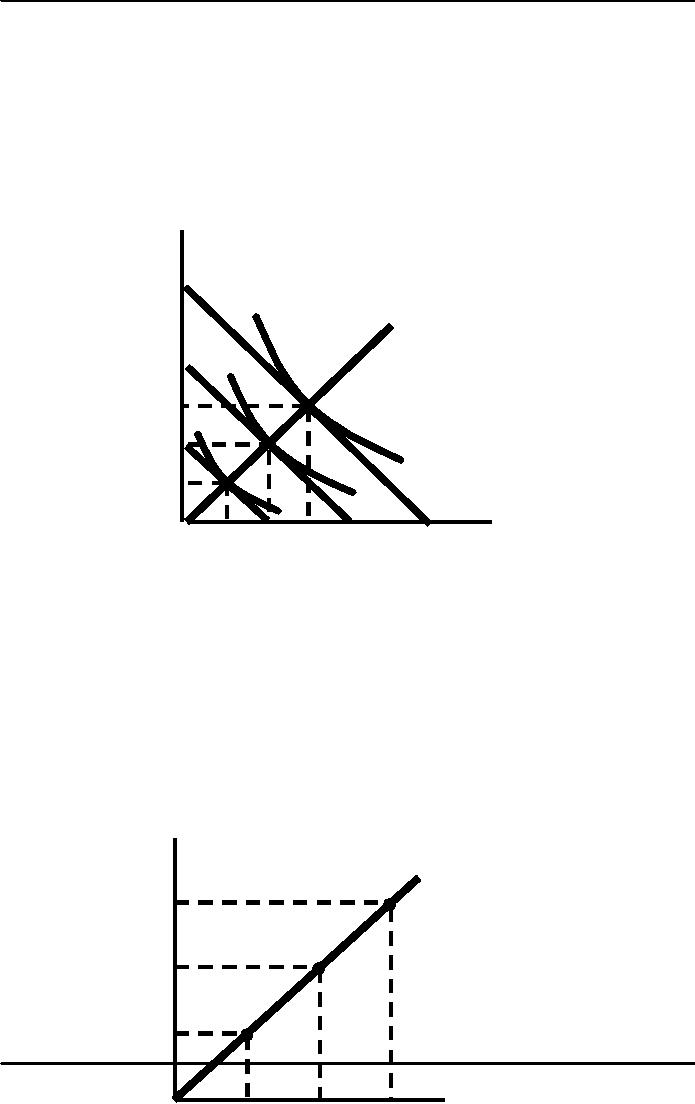
Microeconomics
ECO402
VU
Lesson
20
Cost in
the Long Run
Cost
minimization with Varying
Output Levels
A firm's expansion path
shows the minimum cost
combinations of labor and
capital at each
level
of output.
A
Firm's
The
expansion path
illustrates
Capital
the
least-cost combinations of
per
labor
and capital that can
be
year
used
to produce each level
of
output
in the long-run.
150
$3000
Isocost Line
Expansion
Path
$2000
Isocost
Line
100
C
75
B
50
300
Unit Isoquant
A
25
200
Unit
Isoquan
Labor
per year
100
150
200
300
50
Expansion
Path
Cost
per
Year
Expansion
Path
F
3000
E
A
firm's Long
2000
run
total
cost
curve
D
1000
100
Output,
Units/yr
100
200
300

Microeconomics
ECO402
VU
Long-Run
Versus Short-Run Cost
Curves
What
happens to average costs
when both inputs are
variable (long run) versus
only having
one
input that is variable
(short run)?
101
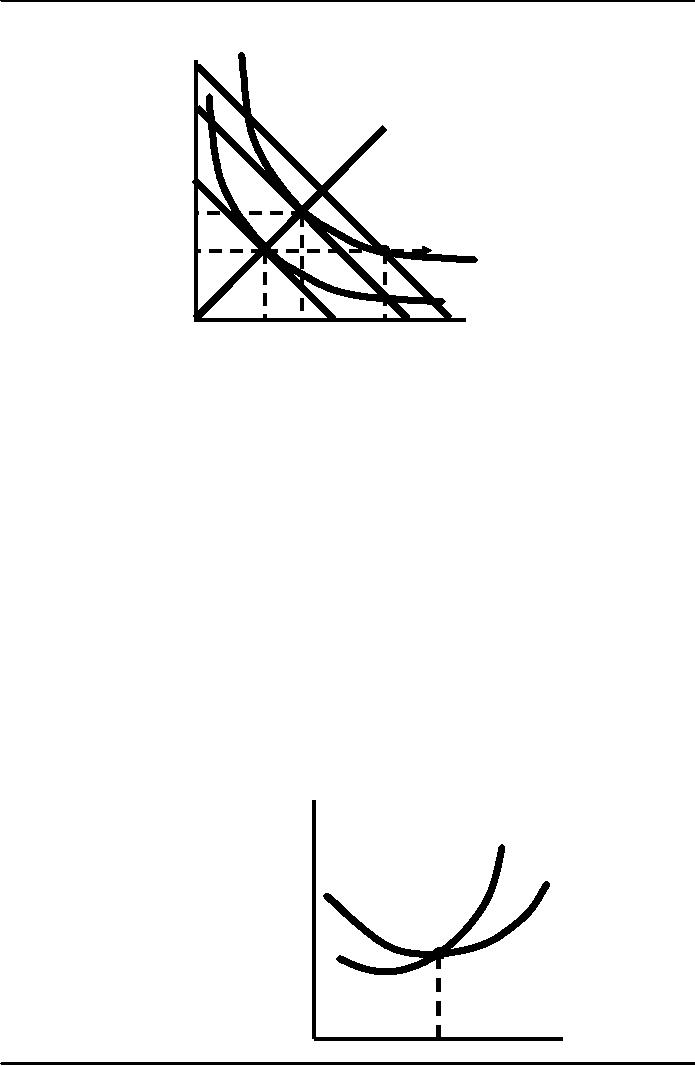
Microeconomics
ECO402
VU
The
Inflexibility of Short-Run
Production
E
Capital
The
long-run expansion
per
path
is drawn as before..
year
C
Long-Run
Expansion
Path
A
K2
Short-Run
P
Expansion
Path
K1
Q2
Q1
L2
L1
L3 D
B
F
Labor
per year
Long-Run
Average Cost (LAC)
Constant Returns to
Scale
�If
input is doubled, output
will double and average
cost is constant at all
levels of output.
Increasing Returns to
Scale
�If
input is doubled, output
will more than double and
average cost decreases at
all levels
of
output.
Decreasing Returns to
Scale
�If
input is doubled, the increase in
output is less than twice as
large and average
cost
increases
with output.
In the long-run:
�Firms
experience increasing and
decreasing returns to scale
and therefore long-run
average
cost is "U" shaped.
Long-run marginal cost
leads long-run average
cost:
�If
LMC < LAC, LAC will
fall
�If
LMC > LAC, LAC will
rise
�Therefore,
LMC = LAC at the minimum of
LAC
Long-Run
Average and Marginal
Cost
Cost($
per
unit
LM
of
output
LA
A
Output
102
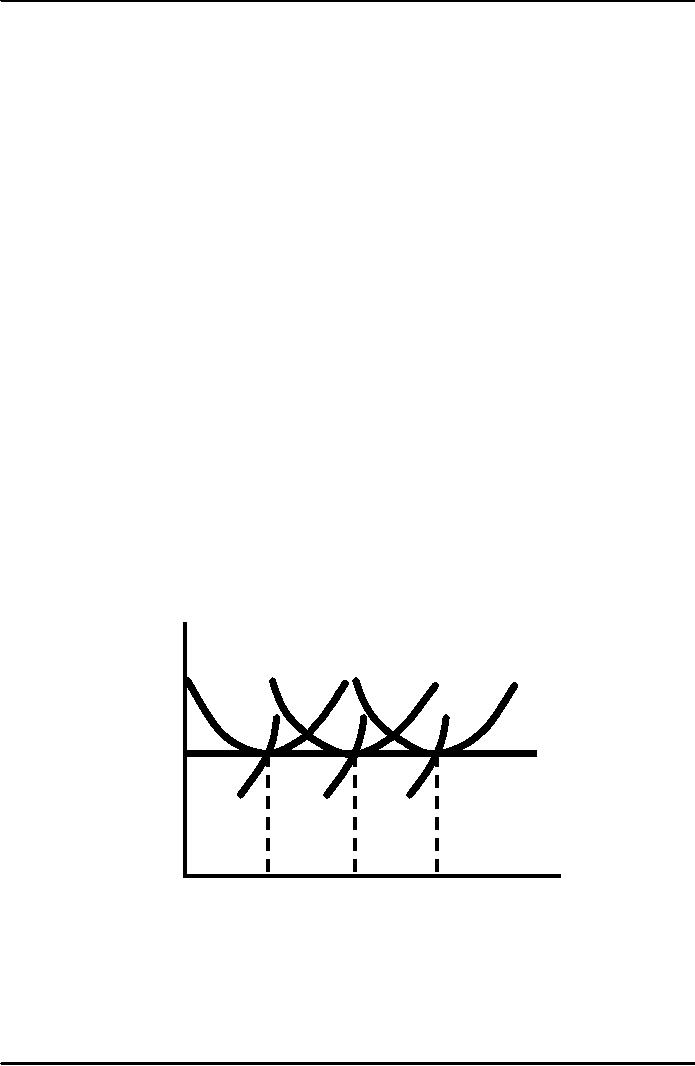
Microeconomics
ECO402
VU
Question
What is the relationship
between long-run average
cost and long-run marginal
cost when
long-run
average cost is
constant?
Economies
and Diseconomies of Scale
Economies of Scale
�Increase
in output is greater than the increase in
inputs.
Diseconomies of
Scale
�Increase
in output is less than the increase in
inputs.
Measuring
Economies of Scale
Ec =
Cost
-
output
elasticity
=
%Δ in
cost from a 1%
increase
in
output
Therefore,
the following is true:
EC< 1: MC < AC
�Average cost indicate
decreasing economies of
scale
EC = 1: MC = AC
�Average cost indicate
constant economies of
scale
EC > 1: MC > AC
�Average cost indicate
increasing economies of
scale
The
Relationship Between Short-Run
and Long-Run Cost
We will use short
and long-run cost to
determine the optimal plant
size
Long-Run
Cost with Constant Returns
to Scale
Cost
With
many plant sizes with SAC =
$10
($
per unit
the
LAC = LMC and is a straight
line
of
output
SAC1
SAC2
SAC3
SMC2
SMC3
SMC
LAC
=
LMC
Q1
Q2
Q3
Output
Observation
The optimal plant
size will depend on the
anticipated output (e.g. Q1 choose SAC1,etc).
The long-run average
cost curve is the envelope
of the firm's short-run
average cost curves.
Question
What would happen to
average cost if an output
level other than that
shown is chosen?
103
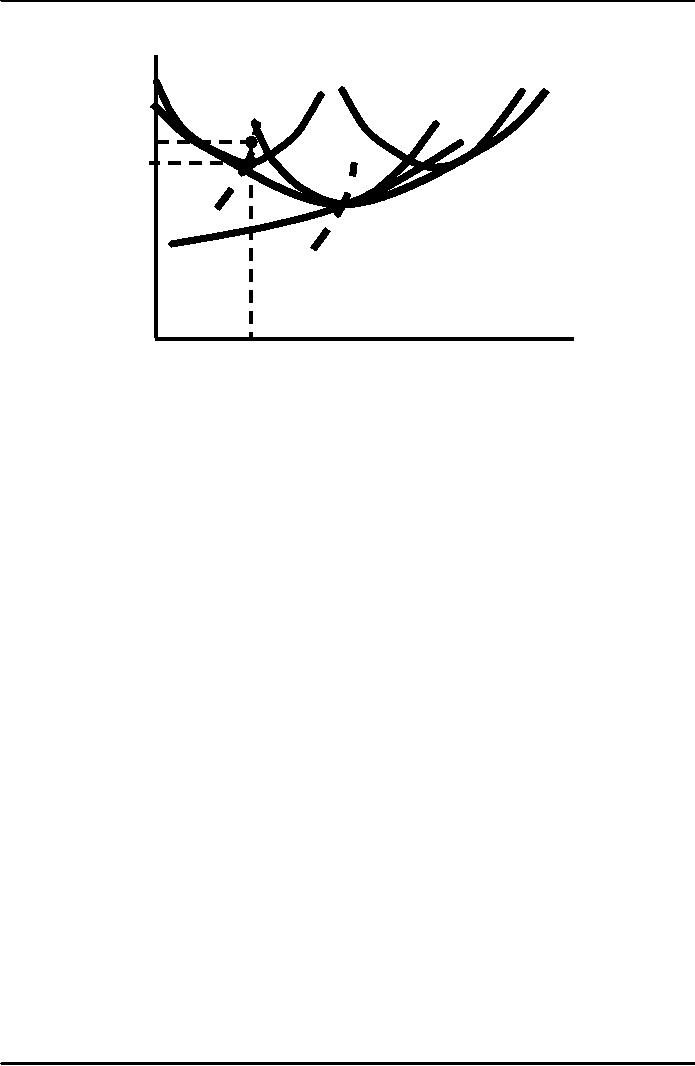
Microeconomics
ECO402
VU
Long-Run
Cost with Economies &
Diseconomies of Scale
Cost
SAC1
($
per unit
LAC
SAC3
of
output
SAC2
A
$10
$8
B
If
the output is Q1 a
SMC1
SMC3
manager
would
chose the small
LMC
SMC2
plant
SAC1 and SAC
$8.
Q1
Output
What
is the firms' long-run cost
curve?
Firms can change
scale to change output in
the long-run.
The long-run cost
curve is the dark blue
portion of the SAC curve
which represents the
minimum
cost for any level of
output.
Observations
The LAC does
not include the minimum
points of small and large
size plants? Why
not?
LMC is not the envelope of
the short-run marginal cost.
Why not?
Measuring
Economies of Scale
Ec = (ΔC/
C) /(ΔQ/
Q)
Ec =(ΔC/ ΔQ)/(C/
Q) = M /A
C C
Therefore,
the following is
true:
EC< 1: MC
< AC
�
Average
cost indicate decreasing
economies of scale
EC = 1: MC =
AC
�
Average
cost indicate constant
economies of scale
EC > 1: MC
> AC
�
Average
cost indicate increasing
economies of scale
The
Relationship Between Short-Run
and Long-Run Cost
We will use
short and long-run cost to
determine the optimal plant
size
104
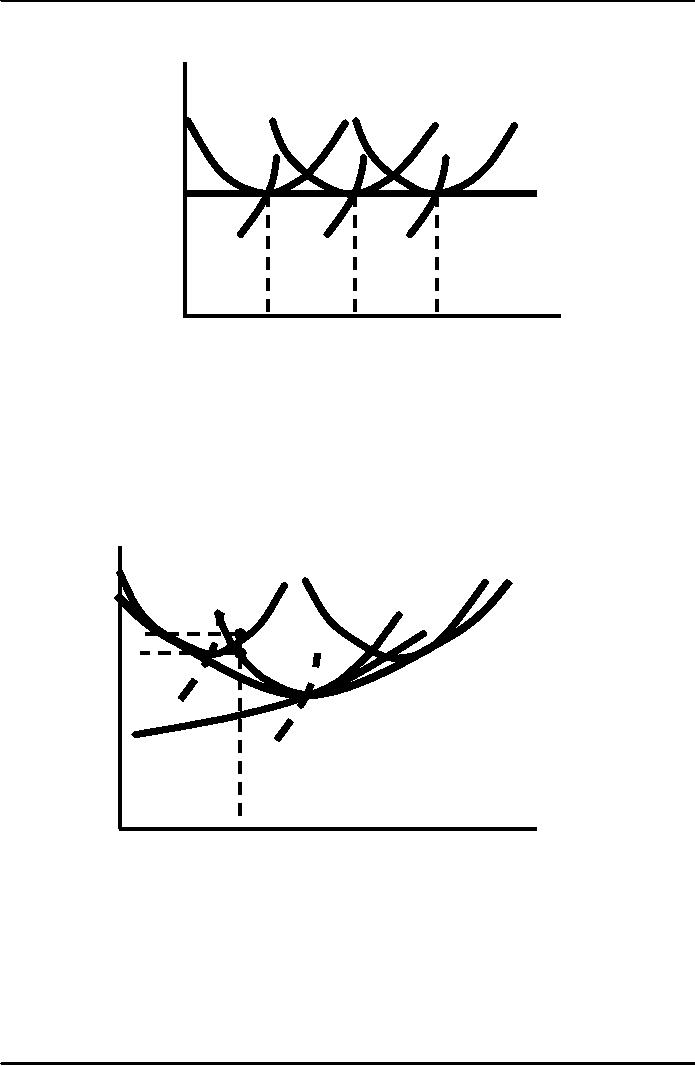
Microeconomics
ECO402
VU
Long-Run
Cost with Constant Returns
to Scale
Cost
With
many plant sizes with SAC =
$10
($
per unit
the
LAC = LMC and is a straight
line
of
output
SAC1
SAC2
SAC3
SMC2
SMC3
SMC
LAC
=
LMC
Q1
Q2
Q3
Output
Observation
The
optimal plant size will
depend on the anticipated
output (e.g. Q1 choose
SAC1,etc).
The
long-run average cost curve
is the envelope of the
firm's short-run average
cost
curves.
Question
What
would happen to average cost
if an output level other
than that shown is
chosen?
Long-Run
Cost with Economies &
Diseconomies of Scale
Cost
SAC1
($
per unit
LAC
SAC3
of
output
SAC2
A
$10
$8
B
If
the output is Q1 a
manager
SMC1
SMC3
would
chose the small
plant
LMC
SAC1 and SAC
$8.
SMC2
Q1
Output
What
is the firms' long-run cost
curve?
Firms can
change scale to change
output in the
long-run.
The long-run
cost curve is the dark
blue portion of the SAC
curve which represents
the
minimum
cost for any level of
output.
Observations
The LAC
does not include the
minimum points of small and
large size plants? Why
not?
LMC is not the
envelope of the short-run
marginal cost. Why
not?
105
Table of Contents:
- ECONOMICS:Themes of Microeconomics, Theories and Models
- Economics: Another Perspective, Factors of Production
- REAL VERSUS NOMINAL PRICES:SUPPLY AND DEMAND, The Demand Curve
- Changes in Market Equilibrium:Market for College Education
- Elasticities of supply and demand:The Demand for Gasoline
- Consumer Behavior:Consumer Preferences, Indifference curves
- CONSUMER PREFERENCES:Budget Constraints, Consumer Choice
- Note it is repeated:Consumer Preferences, Revealed Preferences
- MARGINAL UTILITY AND CONSUMER CHOICE:COST-OF-LIVING INDEXES
- Review of Consumer Equilibrium:INDIVIDUAL DEMAND, An Inferior Good
- Income & Substitution Effects:Determining the Market Demand Curve
- The Aggregate Demand For Wheat:NETWORK EXTERNALITIES
- Describing Risk:Unequal Probability Outcomes
- PREFERENCES TOWARD RISK:Risk Premium, Indifference Curve
- PREFERENCES TOWARD RISK:Reducing Risk, The Demand for Risky Assets
- The Technology of Production:Production Function for Food
- Production with Two Variable Inputs:Returns to Scale
- Measuring Cost: Which Costs Matter?:Cost in the Short Run
- A Firm’s Short-Run Costs ($):The Effect of Effluent Fees on Firms’ Input Choices
- Cost in the Long Run:Long-Run Cost with Economies & Diseconomies of Scale
- Production with Two Outputs--Economies of Scope:Cubic Cost Function
- Perfectly Competitive Markets:Choosing Output in Short Run
- A Competitive Firm Incurring Losses:Industry Supply in Short Run
- Elasticity of Market Supply:Producer Surplus for a Market
- Elasticity of Market Supply:Long-Run Competitive Equilibrium
- Elasticity of Market Supply:The Industry’s Long-Run Supply Curve
- Elasticity of Market Supply:Welfare loss if price is held below market-clearing level
- Price Supports:Supply Restrictions, Import Quotas and Tariffs
- The Sugar Quota:The Impact of a Tax or Subsidy, Subsidy
- Perfect Competition:Total, Marginal, and Average Revenue
- Perfect Competition:Effect of Excise Tax on Monopolist
- Monopoly:Elasticity of Demand and Price Markup, Sources of Monopoly Power
- The Social Costs of Monopoly Power:Price Regulation, Monopsony
- Monopsony Power:Pricing With Market Power, Capturing Consumer Surplus
- Monopsony Power:THE ECONOMICS OF COUPONS AND REBATES
- Airline Fares:Elasticities of Demand for Air Travel, The Two-Part Tariff
- Bundling:Consumption Decisions When Products are Bundled
- Bundling:Mixed Versus Pure Bundling, Effects of Advertising
- MONOPOLISTIC COMPETITION:Monopolistic Competition in the Market for Colas and Coffee
- OLIGOPOLY:Duopoly Example, Price Competition
- Competition Versus Collusion:The Prisoners’ Dilemma, Implications of the Prisoners
- COMPETITIVE FACTOR MARKETS:Marginal Revenue Product
- Competitive Factor Markets:The Demand for Jet Fuel
- Equilibrium in a Competitive Factor Market:Labor Market Equilibrium
- Factor Markets with Monopoly Power:Monopoly Power of Sellers of Labor